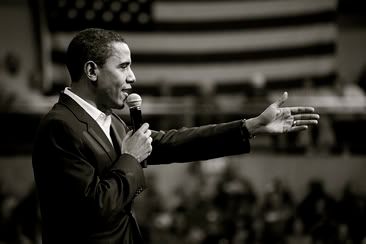The other weekend I attended a campaign precinct captain training session at the new Santa Monica Main Library. I hope to discuss this wonderful building in the future: however, this is my participation in the national discussion regarding who should be the next President of the
While this column is typically dedicated to discussion about the built environment’s social impact, I felt compelled to address the national discussion regarding the future our country as it affects us at local and global level. I spend a lot of my energy working in the community; I understand what it is to stand in often empty meeting halls as you try to rally local residents to help make change in their community. I feel that there is the opportunity to improve my community and those of others’ across this nation with the rise of new national leadership. Not a new leader, but a new type of leader.
Senator Barack Obama’s keynote speech at the 2004 Democratic Convention will be remembered as a defining moment in American political history. It was a moment during which the shackles of partisanship were broken, but not by a single political party’s triumph over another, nor by the rise of a third party carving out the political center. This was a defining moment during which we saw the possibility that our government and nation could move beyond the zero-sum thinking that assumes there must be a winner and a loser. We saw the possibility of a third path based not on compromise but on communication, collaboration and cooperation—an inclusive direction that could lead our nation toward a brighter future.
In my view, there are several qualified candidates that could serve effectively in yet another caretaker Presidential administration. However, Obama is the only candidate with the experience to alter the national DNA at the street level. As a community organizer in a Chicago neighborhood stricken by extreme poverty, crime, high unemployment, and environmental injustice, his power came from bringing residents, businesses, and local stakeholders together to fight for a common purpose. To do so, he needed to have the ability to inspire an often indifferent community to organize against powerful, well-organized, and entrenched institutions. The power of the word, the ability to think outside the box, and extreme tenacity are the tools Obama developed to fight against bureaucracy and indifference, for the benefit of an impoverished neighborhood.
Obama’s experience as a community organizer, Illinois State Legislator, and Congressional Senator gives him a unique perspective from which to understand that real changes comes not through executive action, not through legislation, not from the top down, but through developing a consensus of shared aspirations. Women’s rights, fair working conditions, and civil rights came from hard-fought battles led by public movements on the street. Only when these movements threatened the status quo did the government ratify what had already become common law. Barack Obama will be a leader who does not respond to change, but creates it.
Generating meaningful change at the community level can rarely be attained formulaically; it requires an ability to adapt to often unconventional conditions. This is germane for the “community of nations” as well. Such leadership is evident when Barack Obama states that he will meet with leaders of so-called rogue nations. Of course, there is no guarantee we can find common ground: but if we limit our conversations to those with whom we agree, the possibilities are limited. Diplomacy does not mean compromising principles or capitulating to the demands of others; it means making the attempt to forge difficult but possibly world-changing conversations with those whose ways of life may be distasteful, even abhorrent.
It is only through cooperation—from the level of the community to the global level itself—that we can forge truly positive change in our neighborhoods, our nation, and the world. It is my conviction that Senator Barack Obama alone has the experience to inspire our nation in this way.
Photo credit Vargas

